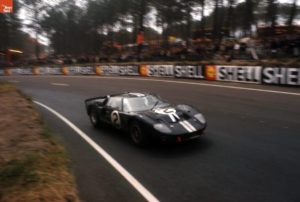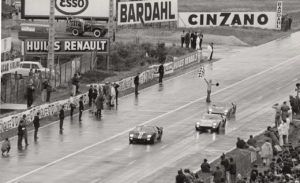Here is a great tidbit for car history buffs. June marks the 50th Anniversary of the 1966 Le Mans 24-hour car race in which Ford achieved a historical 1-2-3 finish. A recent article in Road and Track offers a great summary of the 1966 event:
Le Mans, the first time an American car manufacturer won the classic 24-hour race. Ford came loaded for bear, with eight 7.0-liter GT40 Mk II coupes, seven spare engines and a tractor-trailer loaded with parts.
Although this 1966 Le Mans race is noted for the Mk IIs sweeping the top three positions, the finish itself was quite the controversial affair.
Although the drivers understandably didn’t like it, Ford had decided that the Bruce McLaren/Chris Amon and Ken Miles/Denis Hulme cars should cross the finish line together, for two reasons: It would be the first time ever that a pair of cars would take the overall victory at Le Mans, which would drive home the point that the car, a Ford GT, and not a driver, had won the race. Secondly, it would make for a great publicity photo.
On the last lap, however, within sight of the finish, Ken Miles, leading at the time, suddenly backed off the gas and McLaren in the No. 2 car went a length ahead as they crossed the finish line. Although Miles had slowed his pace to allow this photo finish to happen, it was ruled that McLaren’s Mk II should get credited with the win, because his car—having started several positions behind Miles’ Ford—had traveled a greater distance (estimated by the ACO to be eight meters) in the 24-hour race. This was a huge disappointment to Miles, who had helped Ford develop the car and was hoping to be rewarded with the 1966 triple crown (wins at Daytona, Sebring and Le Mans).
It didn’t really matter to Ford, though. Three Ford GT40s had outclassed the best cars in the world. And, as Leo Levine wrote in The Dust and the Glory: “…the small group of Americans in the Ford pits just stood that much straighter. Phil Remington was one of them. Bill Stroppe was another. It was a long way from the dry lakes of the Mojave, where they took their first Model Ts and flathead V-8s.”


